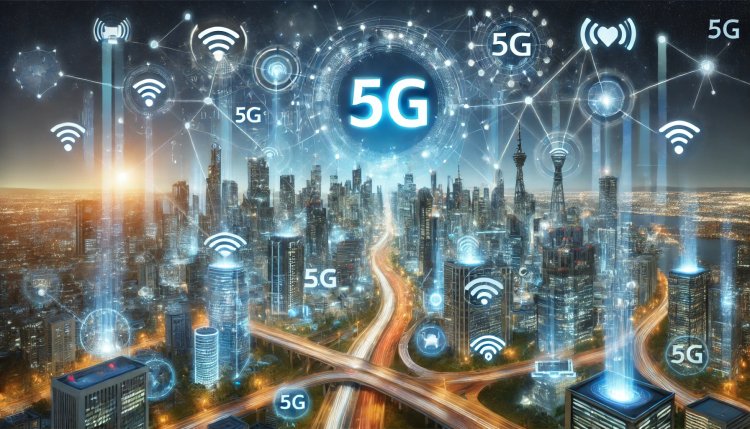The Pros and Cons of 5G: What It Means for the Future of Connectivity

Introduction
The world of technology is evolving at an incredible pace, and 5G is one of the most talked-about advancements in recent years. As the fifth-generation mobile network, 5G promises faster speeds, lower latency, and improved connectivity, but it also comes with challenges and concerns.
Is 5G really the game-changer it claims to be? Or does it come with hidden drawbacks? Let’s dive into the pros and cons of 5G and explore how it will shape the future of connectivity.
What is 5G?
Before we analyze the advantages and disadvantages, let’s understand what 5G actually is.
5G (Fifth Generation Wireless Technology) is the latest upgrade in mobile networks, following 4G LTE. It operates on higher frequency bands and uses advanced network architecture to offer:
- Faster download and upload speeds (up to 10 Gbps)
- Ultra-low latency (as low as 1 millisecond)
- Greater network capacity (connecting millions of devices simultaneously)
5G is expected to revolutionize industries such as healthcare, transportation, gaming, and smart cities. However, like any new technology, it has both strengths and weaknesses.
The Pros of 5G
1. Faster Speeds
One of the biggest benefits of 5G is its lightning-fast internet speed. While 4G LTE offers speeds of around 100 Mbps, 5G can reach up to 10 Gbps, making it 100 times faster than 4G!
What this means for you:
✅ Download high-definition movies in seconds
✅ Faster cloud computing and app performance
✅ Smoother video calls and online meetings
2. Lower Latency
Latency refers to the time it takes for data to travel between devices. In 4G networks, latency is around 50 milliseconds, but 5G reduces it to as low as 1 millisecond.
Why is low latency important?
- Gaming – Lag-free online gaming
- Self-driving cars – Instant communication with sensors for safety
- Healthcare – Remote surgeries using robotic arms
With ultra-low latency, real-time applications will perform seamlessly, improving user experience in multiple industries.
3. Higher Device Capacity
5G can handle millions of connected devices simultaneously, making it perfect for smart cities, IoT (Internet of Things), and industrial automation.
With 4G networks, congestion occurs when too many users connect at once (e.g., in crowded stadiums or concerts). 5G eliminates this issue by allowing massive connectivity without slowing down.
Impact:
- Smart homes & IoT devices (smart refrigerators, lights, and security systems)
- Connected cars & traffic management
- Seamless video streaming and online shopping during peak hours
4. Improved Energy Efficiency
Compared to 4G towers, 5G infrastructure is more energy-efficient. Advanced algorithms allow networks to use energy only when needed, reducing power consumption.
This is beneficial for both mobile carriers (lower operational costs) and the environment (less carbon footprint).
5. Boost to Innovation and Economic Growth
5G is expected to drive global economic growth by enabling new business models and technologies.
Industries that will benefit from 5G:
✅ Healthcare – Remote patient monitoring and telemedicine
✅ Manufacturing – AI-driven automation and robotics
✅ Entertainment – AR/VR gaming, 8K streaming
✅ Education – Virtual reality classrooms
With 5G-powered advancements, businesses will increase efficiency, reduce costs, and create new job opportunities.
The Cons of 5G
1. Limited Coverage and Expensive Infrastructure
Despite its potential, 5G is still in its early stages. Unlike 4G, which has global coverage, 5G is mainly available in urban areas and requires extensive infrastructure.
Challenges:
❌ Short-range signals – 5G waves have a shorter range than 4G, requiring more towers
❌ Expensive implementation – Building 5G networks costs billions
❌ Slow rollout in rural areas – Many regions may not see 5G for years
For people in small towns and villages, 5G may not be a practical solution anytime soon.
2. High Costs for Consumers
While 5G-ready smartphones are becoming more common, they come with a higher price tag. Additionally, 5G data plans may cost more compared to 4G.
Potential costs include:
- Buying a new 5G-compatible smartphone
- Paying for higher-priced 5G mobile plans
- ISP charges for upgrading home internet
Until 5G becomes widely available, these costs might discourage many users from making the switch.
3. Potential Health Concerns
There has been ongoing debate about whether 5G radiation could impact human health. Although no conclusive evidence links 5G to health risks, some researchers believe more studies are needed.
Concerns include:
- Radiation exposure from an increased number of cell towers
- Possible effects on the nervous system and sleep patterns
While leading health organizations like the WHO and FCC state that 5G is safe, public skepticism still exists.
4. Cybersecurity and Privacy Risks
With more devices connected through 5G, the risk of cyberattacks and data breaches increases.
Potential threats:
- Hacking of IoT devices (smart home security, self-driving cars)
- Data privacy concerns due to large-scale data collection
- Increased vulnerability to cybercriminals
Governments and tech companies must invest in strong security measures to protect 5G users from potential cyber threats.
Conclusion: Is 5G the Future?
5G is undeniably a breakthrough in connectivity, offering unmatched speed, low latency, and enhanced capacity. It will revolutionize industries, boost innovation, and improve overall digital experiences.
However, challenges such as high costs, infrastructure limitations, and cybersecurity risks must be addressed before 5G becomes widely adopted.
Will 5G completely replace 4G? Not immediately. While it’s expected to dominate urban areas, 4G will continue to exist in rural regions for the foreseeable future.
What's Your Reaction?














